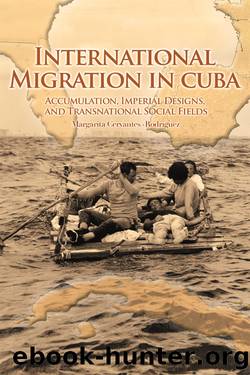International Migration in Cuba by Margarita Cervantes-Rodríguez

Author:Margarita Cervantes-Rodríguez [Cervantes-Rodríguez, Margarita]
Language: eng
Format: epub
Tags: Social Science, Emigration & Immigration
ISBN: 9780271035390
Google: zMfsVb9eh-QC
Publisher: Penn State Press
Published: 2011-05-31T03:23:14+00:00
Labor Shortages, Underemployment, and the Mobility of the Population
Labor shortages in the production of sugar, and in the harvesting of coffee and other crops, have been a structural feature of Cubaâs economy since 1959. However, in sharp contrast with previous acute labor shortages in agricultural production, mainly the sugar industry, this phenomenon has not been related to an impressive expansion in production but to a chronic absolute or relative reduction in the number of workers. A combination of factors explains this outcome. They range from the bias against the owners of small farms and the peasantry and their traditional livelihoodâwhich had historically relied on the cultivation of small parcels of land for self-sufficiency, the private ownership of land and means of production and even the occasional hiring of laborâto population displacements; a sudden increase in social mobility opportunities available to sectors of the rural population, including young men and women, as educational opportunities increased together with employment in the service economy; the expansion of the military; and rising expectations regarding job mobility and educational training. The Cuban government has addressed labor shortages through the voluntary and forced (mainly through political mechanisms) recruitment of university students, young men serving compulsory military service, Young Workersâ Brigades (Brigadas Juveniles del Trabajo), Young Military Workersâ Army (Ejército Juvenil del Trabajo) and other people to cut sugar cane, harvest agricultural products, or participate in any other stage of agricultural production. Seasonal labor shortages in the production of tobacco, coffee, citrus fruits, and other crops have been filled by male and female students from high schools and universities, including students from Africa and other areas who have been granted education in Cuba in exchange for their labor and as part of a broader foreign policy strategy focused on creating allies globally. The use of âbrigadesâ constituted of workers and students for what Carmelo Mesa-Lago (1982) calls âthe transfer of urban labor surplus to the agricultural sectorâ have played an important part in ameliorating chronic labor shortages in the agricultural sector. Sectoral labor scarcity in professional activities has also become a structural feature of Cubaâs political economy since 1959, and has increased with the growing exodus of professionals. This phenomenon has been approached by combining an aggressive educational policy to be able to replace those who left and restrictions on emigration based on age or professional expertise. Labor shortages in some sectors ran parallel to relative labor surpluses in others, including mostly urban activities, given the stagnation or poor performance of the latter. Thus seasonal and sectoral labor shortages have become inextricably linked with underemployment and disguised unemployment.24 In this context, the Cuban government has implemented labor-exporting strategies through âinternationalist brigadesâ and more formal âguest-workerâ types of agreements signed with other governments, either bilaterally or multilaterally, in which the Cuban government has exchanged labor for currency, goods, or political capital. These strategies were put in place during the first years of the revolution and still exist. They have encompassed qualified workers and professionals in occupations related to
Download
This site does not store any files on its server. We only index and link to content provided by other sites. Please contact the content providers to delete copyright contents if any and email us, we'll remove relevant links or contents immediately.
| Antigua | Bahamas |
| Barbados | Cuba |
| Dominica | Dominican Republic |
| Grenada | Haiti |
| Jamaica | Saint Kitts |
| Saint Lucia | Saint Vincent |
| Trinidad and Tobago |
Cat's cradle by Kurt Vonnegut(15258)
Pimp by Iceberg Slim(14434)
4 3 2 1: A Novel by Paul Auster(12330)
Underground: A Human History of the Worlds Beneath Our Feet by Will Hunt(12052)
The Radium Girls by Kate Moore(11973)
Wiseguy by Nicholas Pileggi(5708)
The Fire Next Time by James Baldwin(5382)
Perfect Rhythm by Jae(5355)
American History Stories, Volume III (Yesterday's Classics) by Pratt Mara L(5275)
Paper Towns by Green John(5138)
Pale Blue Dot by Carl Sagan(4954)
A Higher Loyalty: Truth, Lies, and Leadership by James Comey(4906)
The Mayflower and the Pilgrims' New World by Nathaniel Philbrick(4459)
The Doomsday Machine by Daniel Ellsberg(4449)
Killers of the Flower Moon: The Osage Murders and the Birth of the FBI by David Grann(4409)
The Sympathizer by Viet Thanh Nguyen(4342)
Too Much and Not the Mood by Durga Chew-Bose(4302)
The Borden Murders by Sarah Miller(4276)
Sticky Fingers by Joe Hagan(4144)
